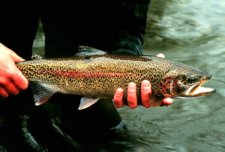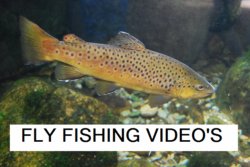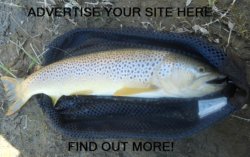|
FISH ON! NOW WHAT?
I like to yell out, fish on when I hook into a fish. Every beginner fly fisherman will eventually get to yell out those very same words at some point. But what do you do when you catch one? Unlike fishing with bait, the fish never swallow the fly. In fact the fly is usually barely attached to their lip or tongue when you land it. Sometimes the fly will come off the fish once you get it into the net. So why do I say this? Because you must bring the fish in differently than you would with a spin caster.
Fish on! If you are using a dry fly you will see the fish take the fly and know you have one. If you are using a wet fly you will need to rely on the feel of the rod, or see the indicator act funny (stop or go under) to know that you have a fish on. An indicator is a piece of yarn or a piece of foam that you attach to the line near the spot where the leader and fly line attach to each other. When it moves in a way contrary to a general float it means something caused that. It could be a fish, or it could be weeds or a stick. You will know soon. So the moment you catch a fish the first two things to do quickly is to make sure your fly line is tight, and make sure your tip is up. You do both of these to put tension on the fish, and not allow the fish any slack to free himself. Once you have done both of these things you can then begin to reel in the fish. Do not reel it in too fast. If it is a big fish or if it is a fish that has a lot of fight it could pull hard and get free. Some times you need to let the fish get tired from pulling. Give him enough drag to pull away a little bit, but still keep the line tight. When the fish quits pulling reel him in some more until he tries to make a run for it, and let him run. Little by little you will get the fish closer and eventually you will be able to net the fish. I mentioned the fact that you need to get the tip up. This is really important. By keeping the tip up you are trying to get the fish head at or above the water level because he won’t be able to fight as much. Sometimes instead of raising your arm above your head you can go horizontal. It just depends on the surroundings and what the fish is doing. All you need to know when you have a fish on is to keep your fly line tight, and don’t rush it!
Are you keeping the fish or letting it go? In some streams it is catch and release only and you need to follow those guidelines. When it is not catch and release and you can keep the fish, will you? By practicing catch and release you are helping to insure future good fishing days for yourself and others. Try to keep the fish in the water secured by your net when possible. Don’t take the fish out of the water if you don’t have to. Fish can survive for a while out of water, long enough to get a good picture, but try to keep it short. Once you have your photo it is time to put the fish back in the stream. You need to make sure the fish is well enough to swim away when you put it back. At times you will need to move the fish back and forth (front to back) in the water until you feel the fish wanting to swim away. By helping the fish get the oxygen through its gills it will be ready to swim away and return to its favorite spot quickly.
|





 Catch and Release
Catch and Release




